Userpilot vs Help Scout: Which is Best for Your SaaS?
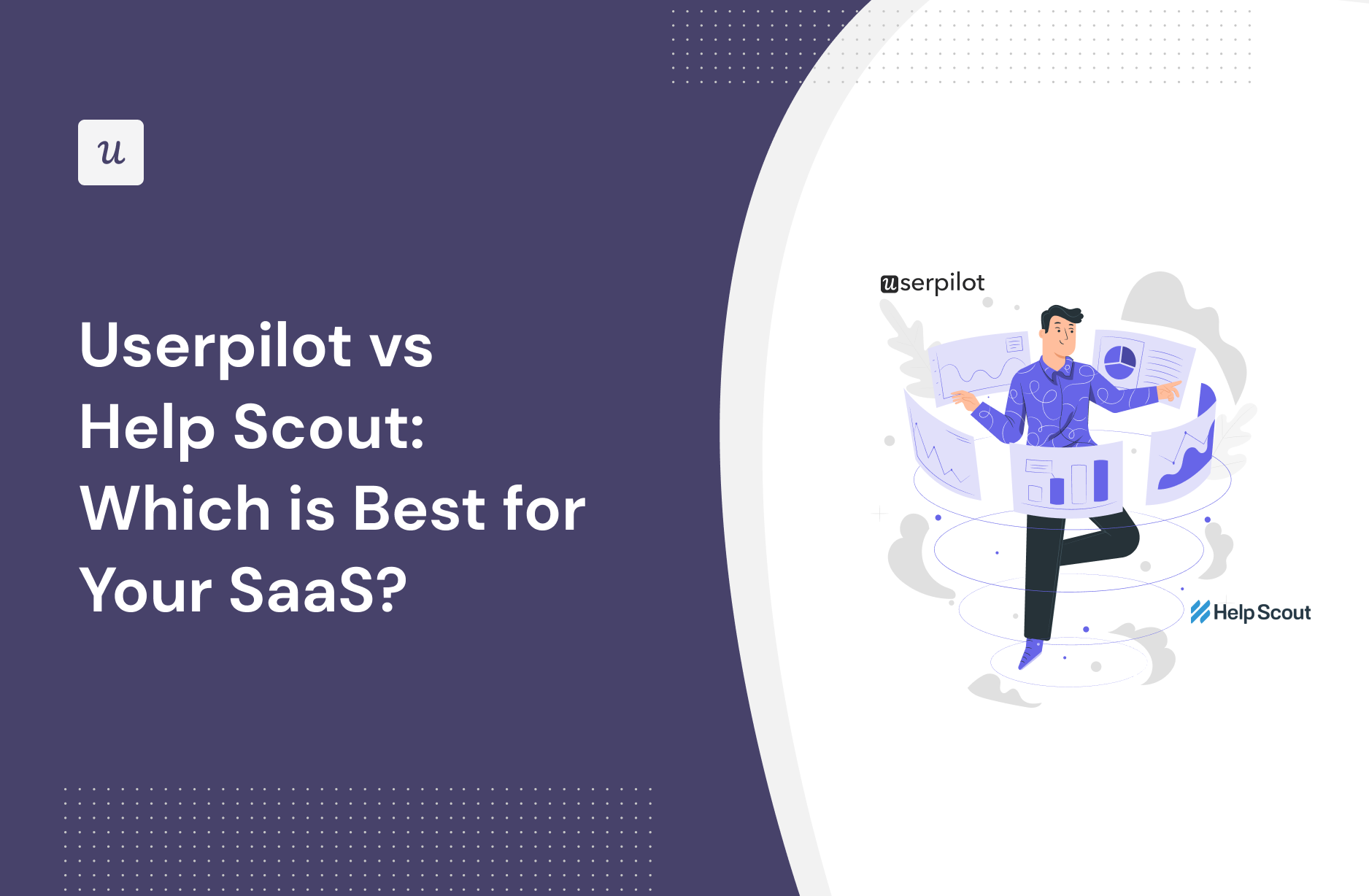
Wondering whether Userpilot or Help Scout is the best option for your SaaS company?
This article is going to dive into the Userpilot vs Help Scout debate and try to answer a key question: Which is the better tool for user onboarding, as well as other use cases?
In the post below, we’ve covered all the common use cases and done an in-depth analysis of the key features of Userpilot and Help Scout – as well as explaining which one is better in certain cases.
Let’s get into it!
TL;DR
- Let’s explore how Userpilot, and Help Scout compare when it comes to user onboarding and other common use cases.
- Userpilot is a product growth platform that drives user activation, feature adoption, and expansion revenue. It also helps product teams collect user feedback, streamline onboarding, and gather actionable insights from analytics.
- Help Scout is a help desk software solution designed to help businesses provide seamless customer support. The platform offers a broad spectrum of features, including shared inbox, live chat, and knowledge base, to manage and organize customer support interactions.
- However, in certain situations, Help Scout offers several features that help monitor and manage customer support interactions. However, if you’re looking for an all-in-one platform that lets you handhold users with hyper-personalized in-app experience, Help Scout pales in comparison to Userpilot. Here are a few areas where Userpilot takes the lead:
- Advanced user onboarding features: Whether you want to create interactive product walkthroughs or onboarding checklists, Userpilot makes the process easy. It offers a no-code interface to design and implement seamless in-app flows. You can even segment users into different groups for personalized onboarding. Help Scout doesn’t offer such functionalities.
- In-depth user analytics: Userpilot offers a detailed glimpse into in-app user behavior to help you understand how different users navigate your product. You can even set up custom events and conversion funnels to track user activity. Help Scout’s analytics capabilities are limited to response times, happiness scores, and other basic metrics.
- Extensive feedback options: Unlike Help Scout, Userpilot doesn’t limit feedback collection to microsurveys and NPS surveys. Instead, you can create and implement a wide array of surveys, including NPS, CSAT, and reaction-based surveys, using pre-designed templates. Also, you can trigger personalized in-app experiences based on qualitative survey responses.
- Get a Userpilot demo for user onboarding and drive your product growth code-free.
![]()
Userpilot – A Better Alternative for Your SaaS

What is Userpilot?
Userpilot is a product growth platform that drives user activation, feature adoption, and expansion revenue. It also helps product teams collect user feedback, streamline onboarding, and gather actionable insights from analytics.

With Userpilot, you’ll be able to track both product usage and user behavior to get a holistic view of how customers use your product — which will guide future development, improve the user experience, and inform your growth efforts.
What is Help Scout?
Help Scout is a help desk software solution designed to help businesses provide seamless customer support. The platform offers a broad spectrum of features, including shared inbox, live chat, and knowledge base, to manage and organize customer support interactions.
Help Scout lets you assign customer conversations to specific team members and resolve urgent requests on priority. You can even set up workflows to automate routine tasks and speed up response times.
Additionally, the live chat feature lets you communicate with customers in real time and provide immediate assistance. You also have the option to collect user feedback through microsurveys and NPS (Net Promoter Score) surveys.
Userpilot vs Help Scout for user onboarding
In this section of the article, we’re really going to compare Userpilot vs Help Scout in terms of user onboarding. That way, we’ll be able to figure out which tool – Userpilot or Help Scout – is the best option depending on your use case.
Userpilot for user onboarding
User onboarding is a crucial part of the customer journey as it speeds up the adoption process and increases retention rates. Onboarding is one of Userpilot’s core use cases along with product growth analytics and user feedback, so it has plenty of features that you can utilize.
Here are some Userpilot features you can use when onboarding new users:
- No-code builder: Creating flows with Userpilot is as simple as installing the Chrome extension, selecting the UI patterns you’d like to use, and then editing the content/settings to suit your use case. You can also use templates to create modals, slideouts, tooltips, and driven actions.

- Native tooltips: Userpilot lets you create native tooltips that show up when users hover over an element or click on an information badge. Since these native tooltips attach to the element itself, they aren’t page-dependent and will show up on any screen where that element is visible.

- Funnel analytics: Userpilot’s advanced analytics lets you create funnel reports that track the onboarding journey. You can also add filters (like name, user ID, signup date, operating system, country, etc.) and monitor the total conversion rate from the first step of the funnel to the last.
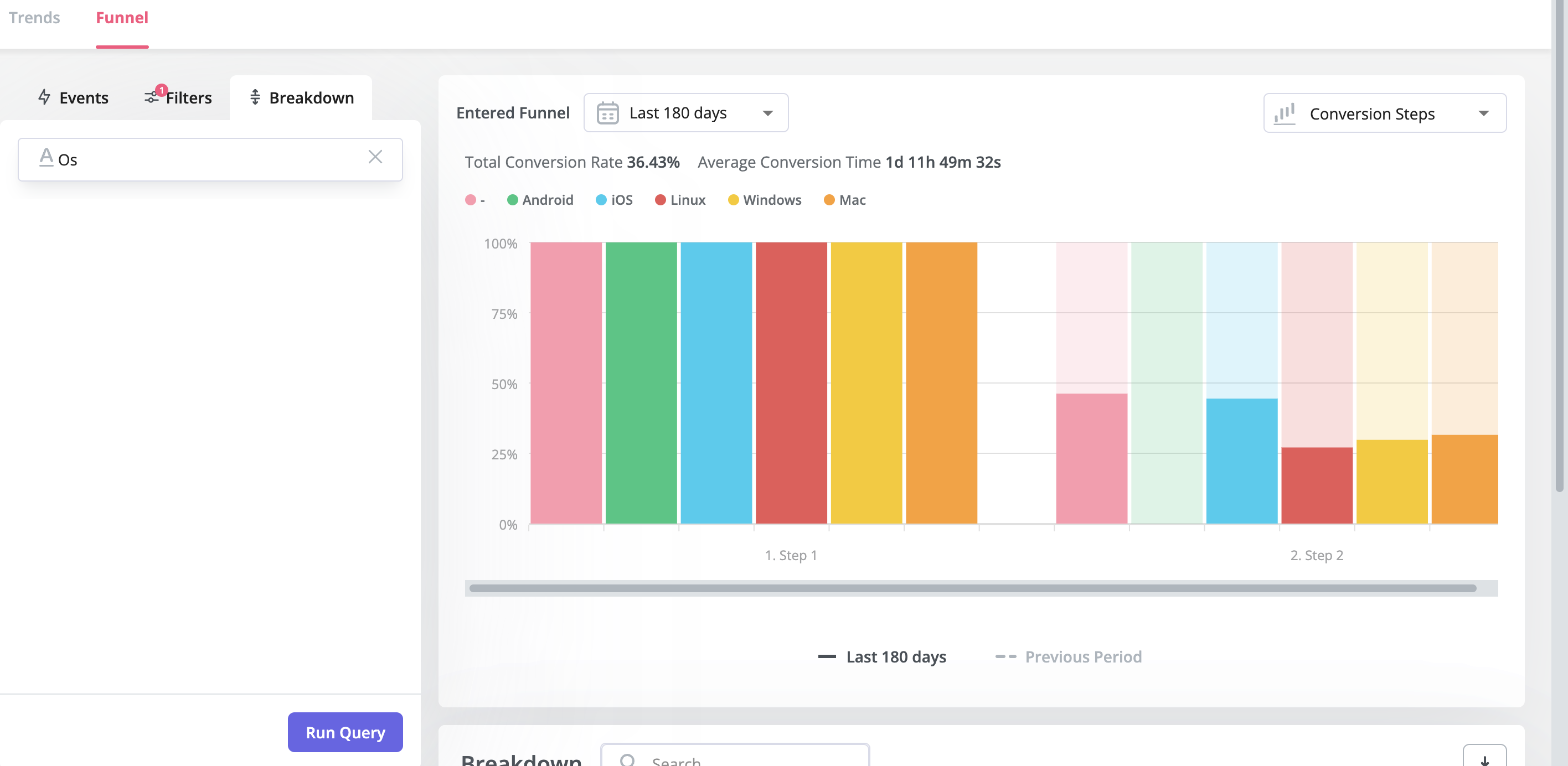
- User segmentation: Userpilot lets you segment users based on the device they’re using, where they’re located, their engagement data, or which NPS rating they selected on the latest survey. You can then filter your analytics dashboards to see which segments struggle with onboarding.

Help Scout for user onboarding
A frictionless onboarding experience plays a crucial role in converting free trial users to paid ones. It can also help drive feature adoption and user retention.
Unlike Userpilot, Help Scout doesn’t offer tools to design targeted product tours or walkthroughs to handhold new users. Nevertheless, it comes with a few features that can support your onboarding efforts. These include:
- The Beacon tool lets you provide contextual support to new users. You can create a Beacon to recommend relevant knowledge base articles or encourage them to reach out to you via the live chat option. Additionally, you can customize the Beacon’s appearance to match your product’s branding.
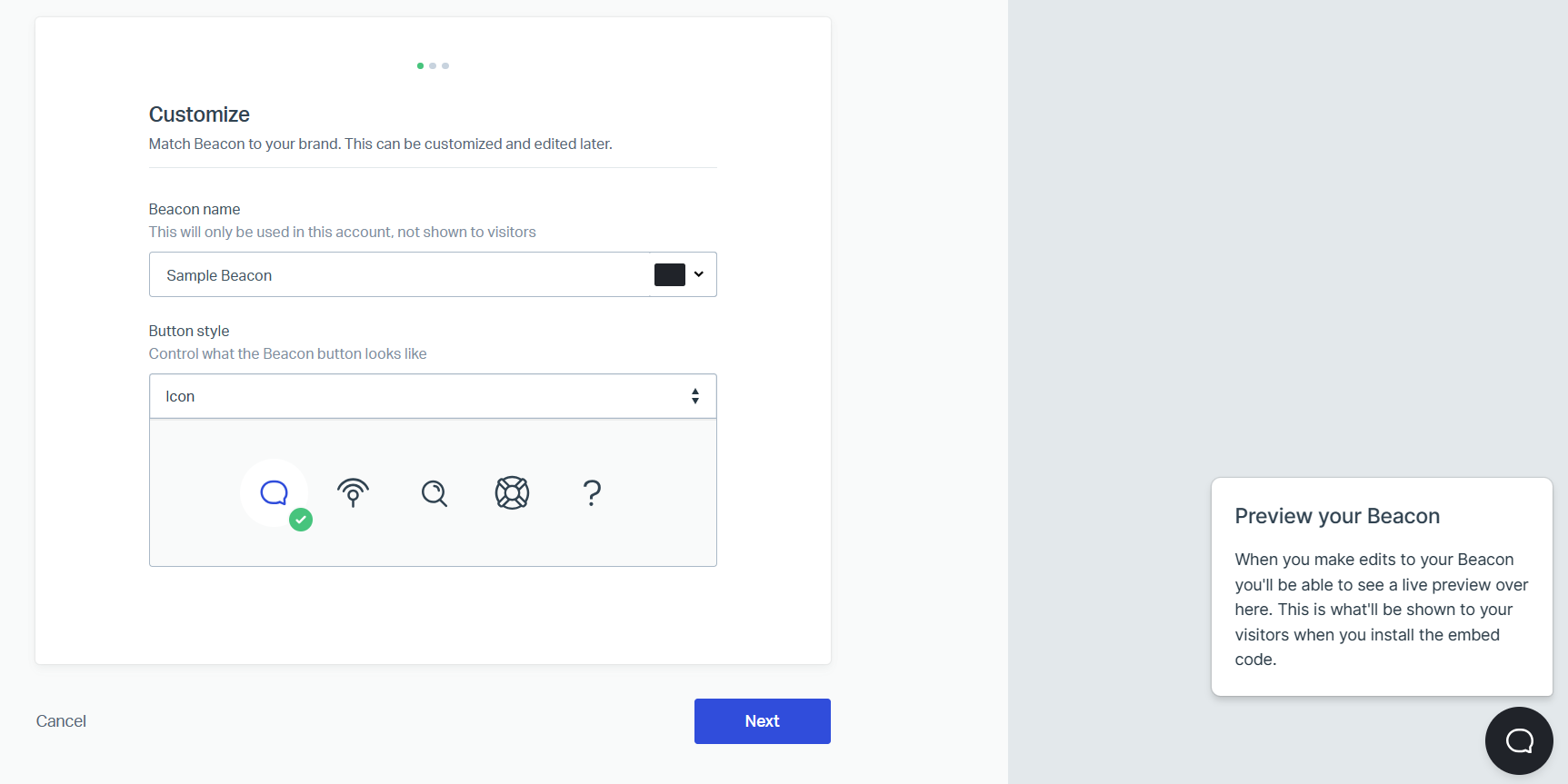
Beacon tool.
- If you’ve created a Beacon, you can use the Messages feature that lets you gently nudge users to check out product tours or setup guides. You can even send them important announcements regarding new features or upcoming outages. Timely updates can be crucial to minimizing friction in the user journey.

Messages in Beacon.
- The Docs features lets you build a robust knowledge base. You can create articles addressing common user queries or provide step-by-step instructions for different tools. You can even organize articles into different categories, making it easier for users to find relevant content.

Creating knowledge base.
Userpilot vs Help Scout for product adoption
In this section of the article, we’re really going to compare Userpilot vs Help Scout in terms of product adoption. That way, we’ll be able to figure out which tool – Userpilot or Help Scout – is the best option depending on your use case.
Userpilot for product adoption
Product adoption is when users become repeat users of your product. It covers the entire journey spanning from the awareness stage to trial signup and finally full-on adoption. As a product growth platform, Userpilot has advanced analytics capabilities for tracking adoption over time.
Here are the Userpilot features that can help you measure and improve product adoption:
- Product analytics: Userpilot lets you create trend reports to track adoption over time by feature or segment, funnel reports that show you which steps of the process most users get stuck on, and integrations with third-party analytics providers so you can sync data between tools.
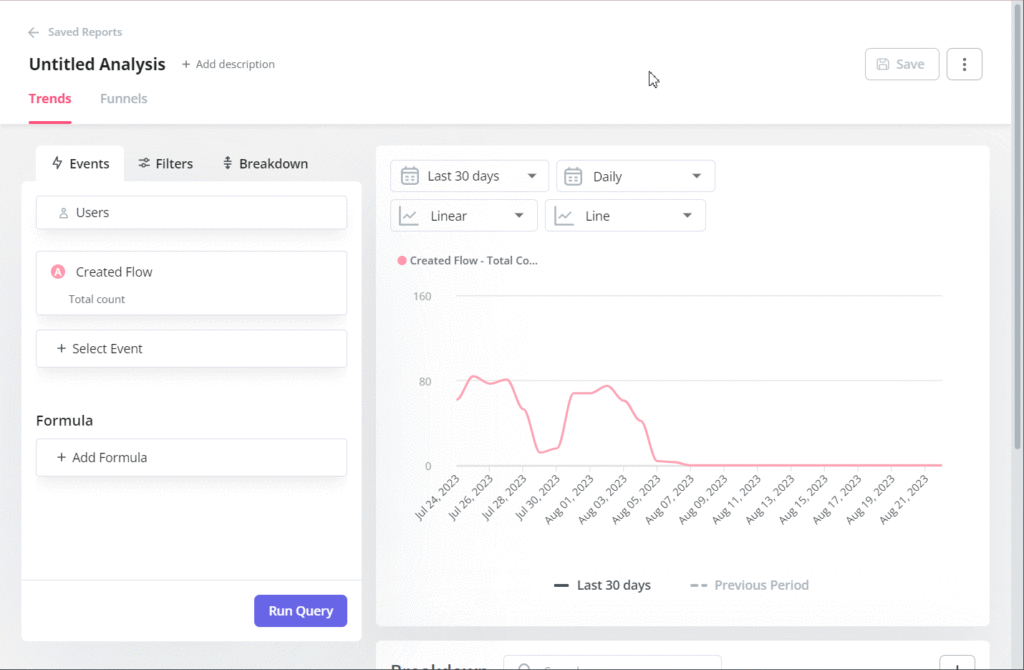
- Product usage dashboard: It collects all your key product usage metrics automatically without you having to set anything up: your Daily, Monthly, and Weekly Active Users and Companies, Trends of Active Users and Companies over time, user stickiness, top pages, features, and events, as well as the most engaged users, highest user activity times throughout the day, user retention, average session duration and product usage by browser.

- Feature engagement: Userpilot’s click-to-track feature tagger lets you see how often a feature is used and by how many people. You’ll also be able to see the top 20 events for a certain time period or create custom events that group multiple features together for clearer insights.

- Feedback collection: Userpilot has a no-code survey builder with 14 templates to choose from. You’ll be able to collect quantitative data like CSAT, CES, or NPS ratings and qualitative feedback on the strongest/weakest parts of your product straight from your users.

- User insights: The Insights dashboard lets you monitor user activity based on which segment they’re in and which company they’re from. You’ll also be able to choose from daily, weekly, and monthly time periods to see if user activity is shifting towards full product adoption over time.

Help Scout for product adoption
A frictionless onboarding experience plays a crucial role in converting free trial users to paid ones. It can also help drive feature adoption and user retention.
Unlike Userpilot, Help Scout doesn’t offer tools to design targeted product tours or walkthroughs to handhold new users. Nevertheless, it comes with a few features that can support your onboarding efforts. These include:
- The Beacon tool lets you provide contextual support to new users. You can create a Beacon to recommend relevant knowledge base articles or encourage them to reach out to you via the live chat option. Additionally, you can customize the Beacon’s appearance to match your product’s branding.

Beacon tool.
- If you’ve created a Beacon, you can use the Messages feature that lets you gently nudge users to check out product tours or setup guides. You can even send them important announcements regarding new features or upcoming outages. Timely updates can be crucial to minimizing friction in the user journey.

Messages in Beacon.
- The Docs features lets you build a robust knowledge base. You can create articles addressing common user queries or provide step-by-step instructions for different tools. You can even organize articles into different categories, making it easier for users to find relevant content.

Creating knowledge base.
Userpilot vs Help Scout for customer experience
In this section of the article, we’re really going to compare Userpilot vs Help Scout in terms of customer experience. That way, we’ll be able to figure out which tool – Userpilot or Help Scout – is the best option depending on your use case.
Userpilot for customer experience
Userpilot gives you an eagle-eye view of the customer experience through user analytics, trend/funnel reports, and feedback collection through different types of surveys.
Here’s how you can use Userpilot to track and analyze customer experience insights:
- User analytics: The users dashboard gives you an overview of all your users while letting you sort by segment, company, or when they were last seen. You can also export user data in bulk as a CSV or click on the Insights tab to see segment-specific insights for a given time period.
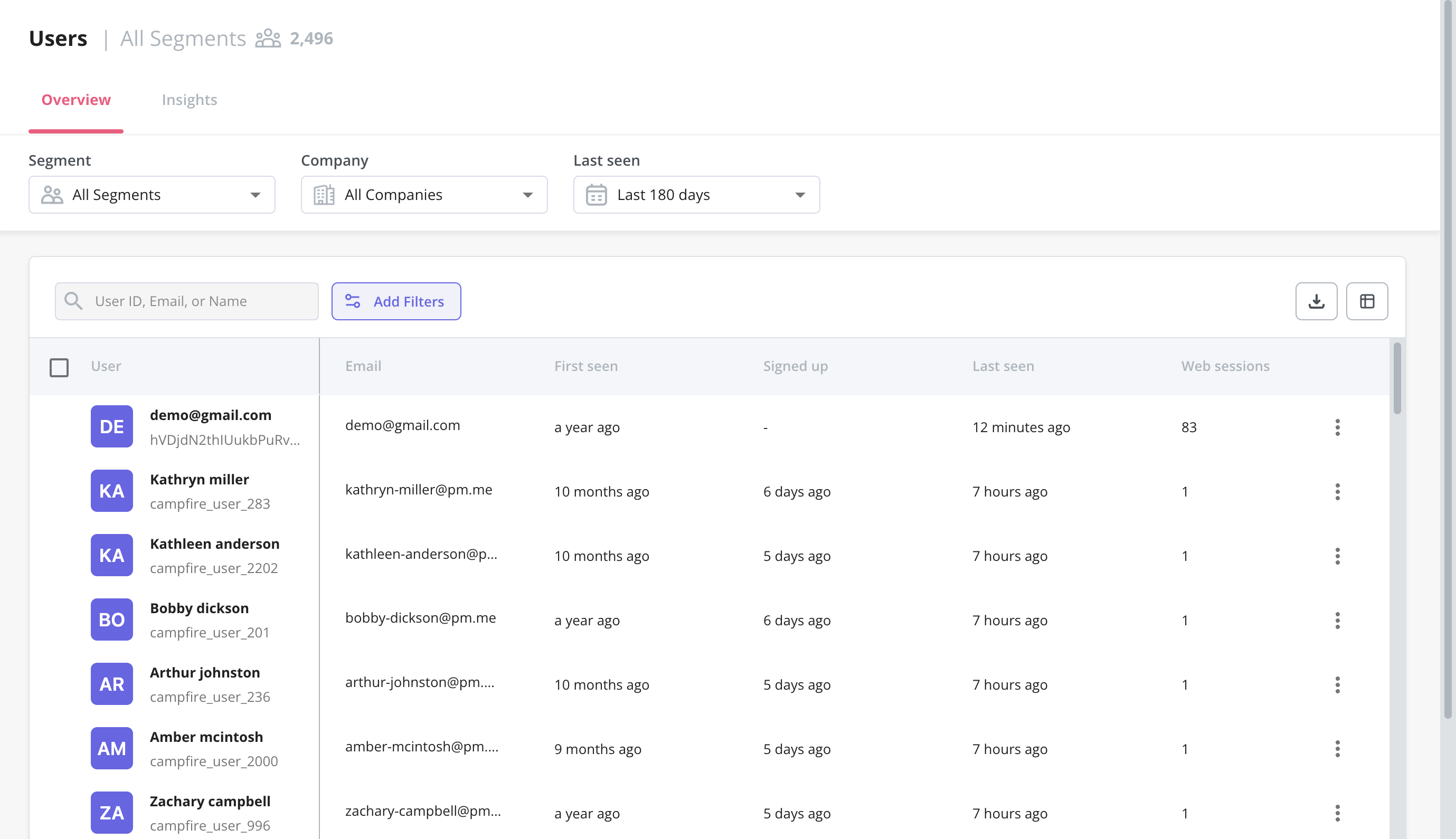
- Trends and funnels: Userpilot’s trends and funnels reports let you track certain events like a specific feature’s usage, add filters to narrow down the data, and then create a breakdown based on segmentation data or user attributes — offering quick and actionable CX reports.

- Satisfaction benchmarking: Userpilot has a built-in NPS dashboard that tracks customer loyalty over time. In addition to the NPS dashboard, you can also use Userpilot’s survey templates to run CSAT or CES surveys and gather additional quantitative and qualitative insights on the customer experience.
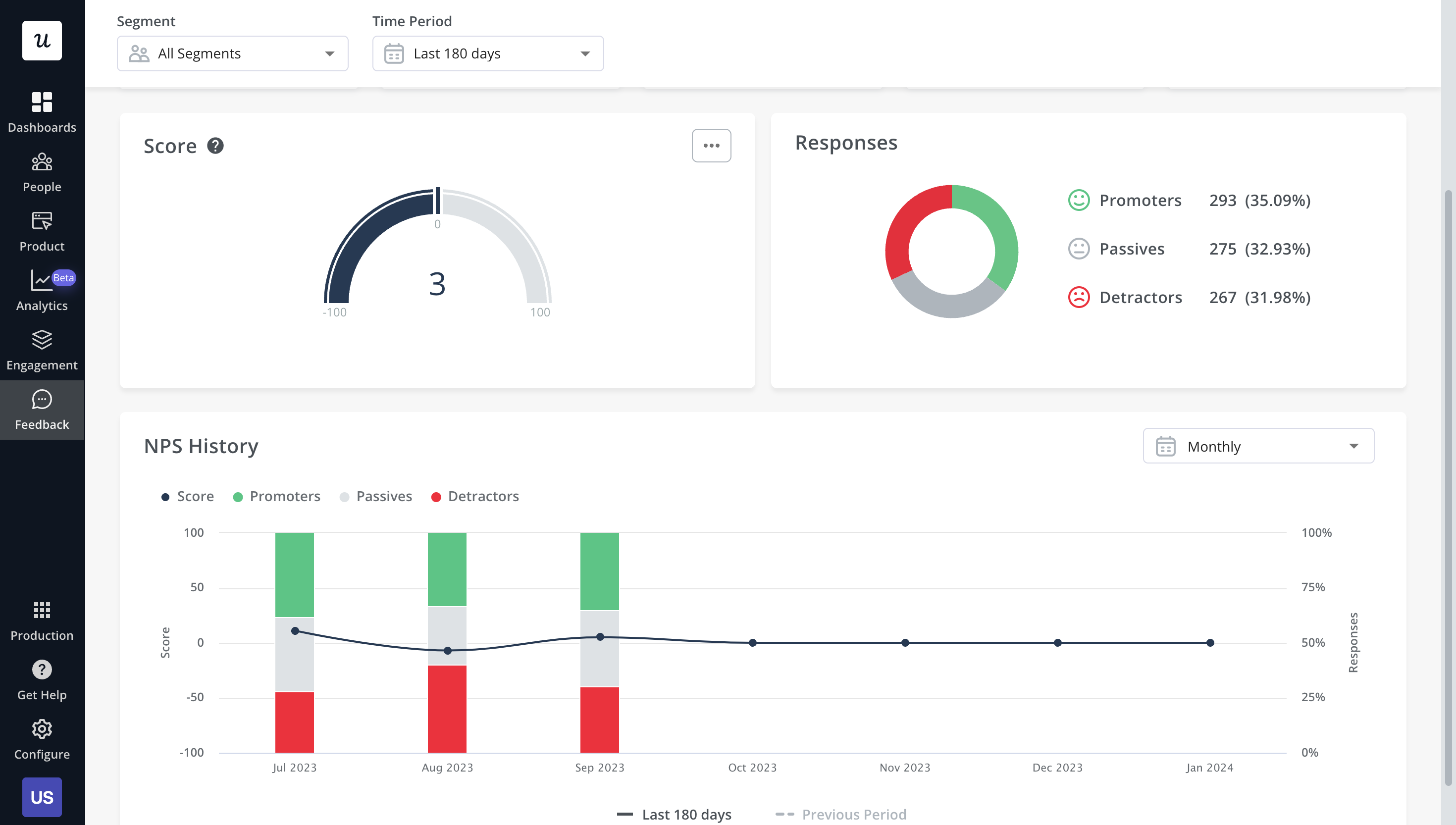
- Self-service support: Userpilot lets you build in-app resource centers, which can include feedback widgets to collect feedback passively, checklists to walk users through specific processes, or integrations with knowledge bases to leverage existing documentation.

- In-app flows: Userpilot’s no-code flow builder helps you create product experiences that can help you optimize the customer experience by educating customers and reducing their time-to-value (TTV). All UI patterns are available on every Userpilot plan from Starter to Enterprise.

Help Scout for customer experience
As a help desk platform, Help Scout offers several features to facilitate seamless communication with users and improve the customer experience.
The features that come in handy include:
- The shared inbox lets you manage customer conversations across different channels in a single dashboard. You can add relevant tags to each conversation to help team members understand the level of priority. Also, you can assign team members to a conversation.
- Each conversation thread includes the user’s complete profile with details like their job title, location, and previous customer support interactions. That makes it easy for your team members to deliver contextually relevant and prompt assistance.

Conversation thread.
- Additionally, the Docs feature lets you create a collection of knowledge base articles. You can use it to build an in-app help center that educates users about different product features and use cases. You can even set up a Beacon to recommend relevant support resources at the right time.

Chat Beacon.
- The Beacon feature also facilitates live chat support. You can even use a Beacon to set up different in-app messages, modals, banners, and surveys. These tools come in handy for maintaining seamless communication with users and understanding what they think about your product.
Userpilot vs Help Scout for user feedback
In this section of the article, we’re really going to compare Userpilot vs Help Scout in terms of user feedback. That way, we’ll be able to figure out which tool – Userpilot or Help Scout – is the best option depending on your use case.
Userpilot for user feedback
User feedback is an essential part of listening to the Voice of the Customer (VoC) and making product development or marketing decisions that best suit your customer base. Userpilot has a no-code survey builder, 14 templates to choose from, and advanced analytics for extracting insights.
Here are the Userpilot features you can use to collect customer feedback and analyze it:
- Survey builder: Userpilot’s survey builder lets you edit the content, update the widget’s style/placement, and set page-specific or event-specific triggers to ensure that users see the survey at the most contextual moment — all without writing a single line of code. You can also translate surveys into your audience’s native language.

- Survey templates: There are 14 survey templates to choose from with a wide array of different use cases. You can collect qualitative responses on how to improve the user/product experience or quantitative data for customer satisfaction benchmarking such as CSAT and CES scores.
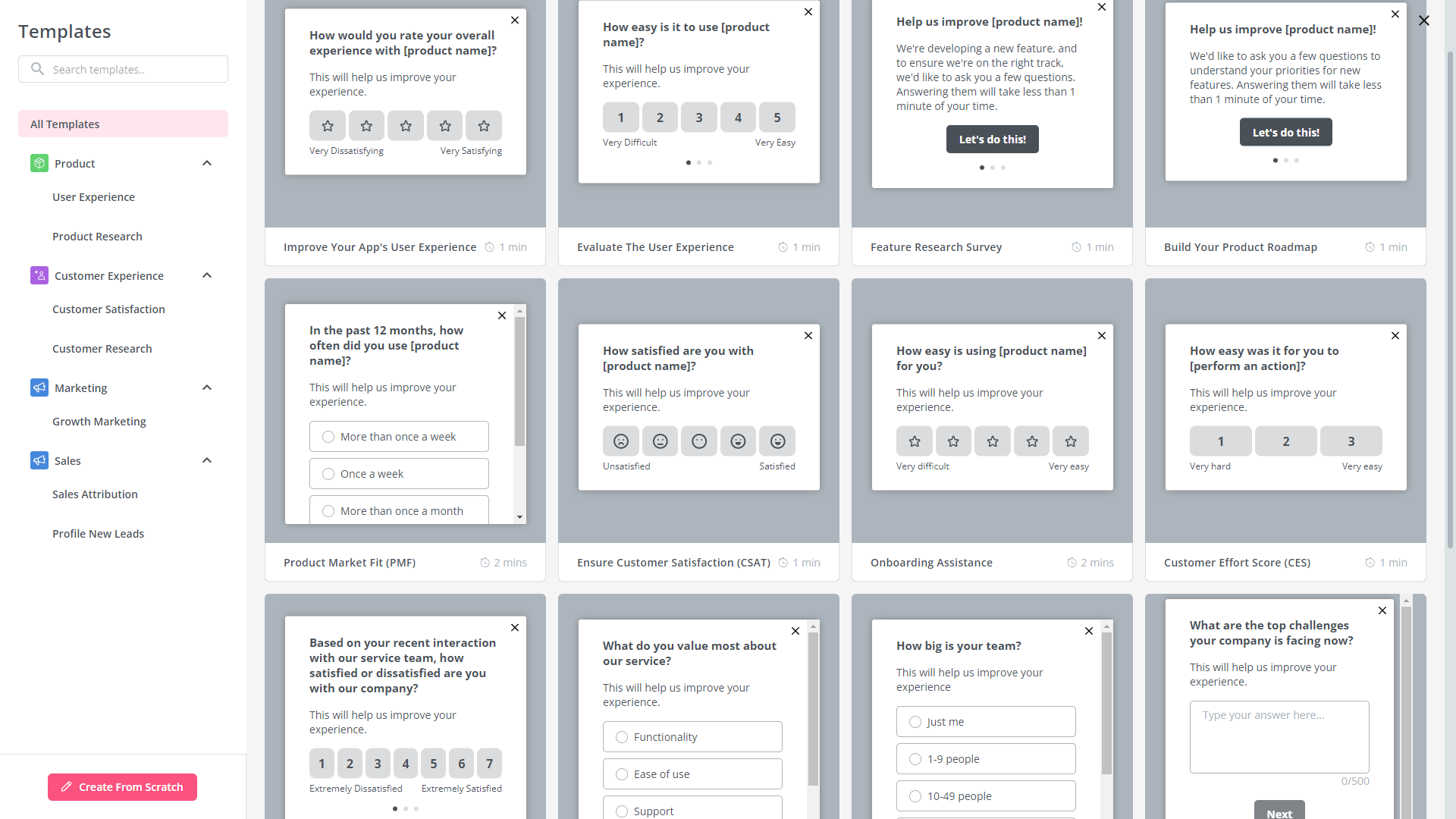
- Advanced analytics: Userpilot’s advanced survey analytics will show you what the most common responses were, what percentage of users selected a specific option, and display open-ended feedback about your product or specific features.
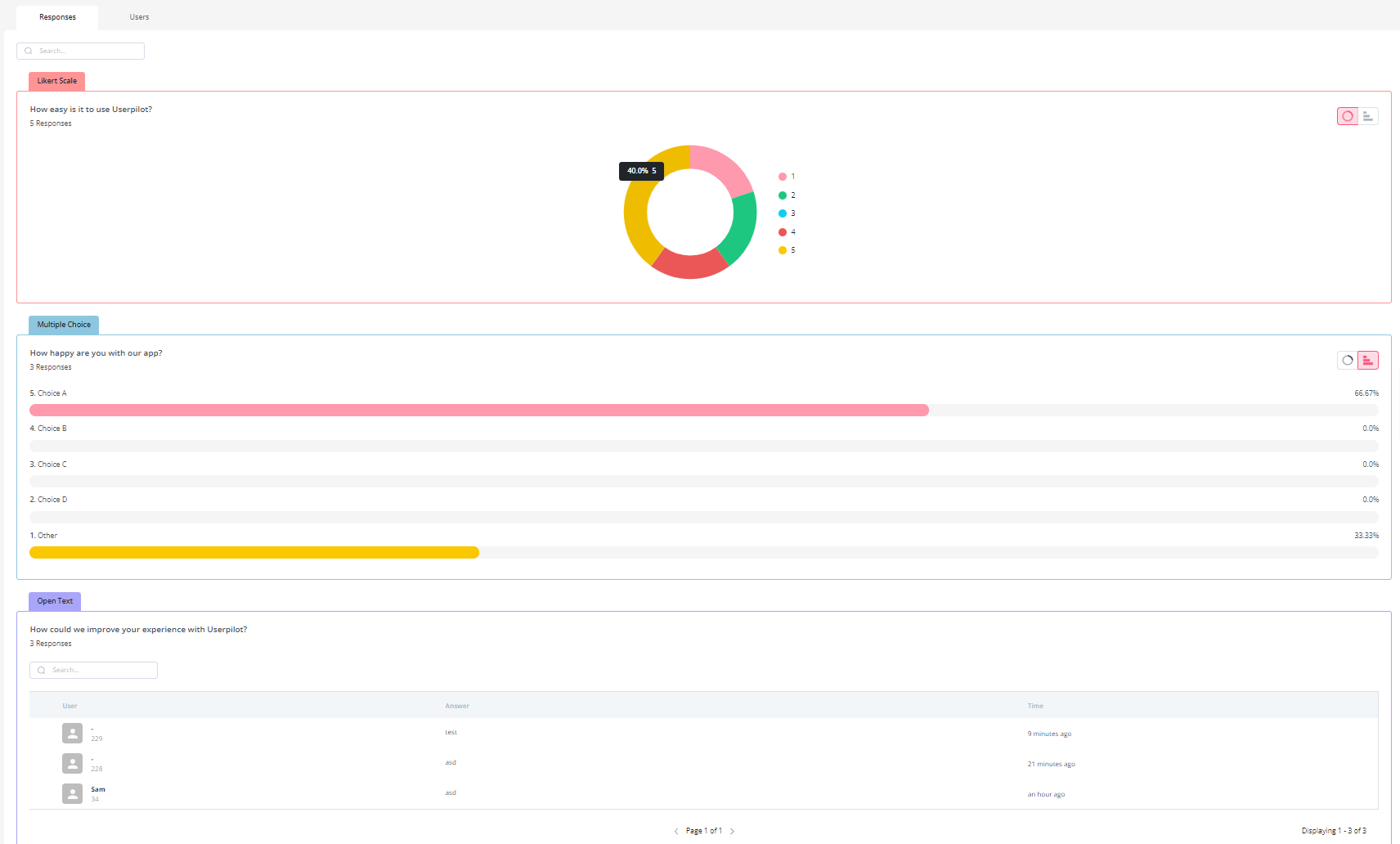
- NPS dashboard: Userpilot’s NPS dashboard compiles response data from all NPS surveys so you don’t have to manually go into each survey and check its analytics. You’ll be able to view key metrics like response rates, total views, and NPS history and sort all the data by different segments.

Help Scout for user feedback
Whether you want to drive feature adoption, user retention, or product activation, feedback collection is crucial. While there are several ways to collect user feedback, in-app surveys are particularly effective.
Here’s how you can use Help Scout to implement in-app surveys:
- The Messages feature offers two survey options – NPS and microsurveys. While NPS surveys offer insights into user loyalty and churn, microsurveys come in handy for understanding how users feel about new features or upgrades.

Microsurvey creation.
- You can customize various aspects of the survey, including its questions, response type, and confirmation text. For instance, you can select the Text survey type when you want to collect detailed feedback about a new feature. Similarly, you can use the Multiple Choice survey type to get an idea of user preferences.
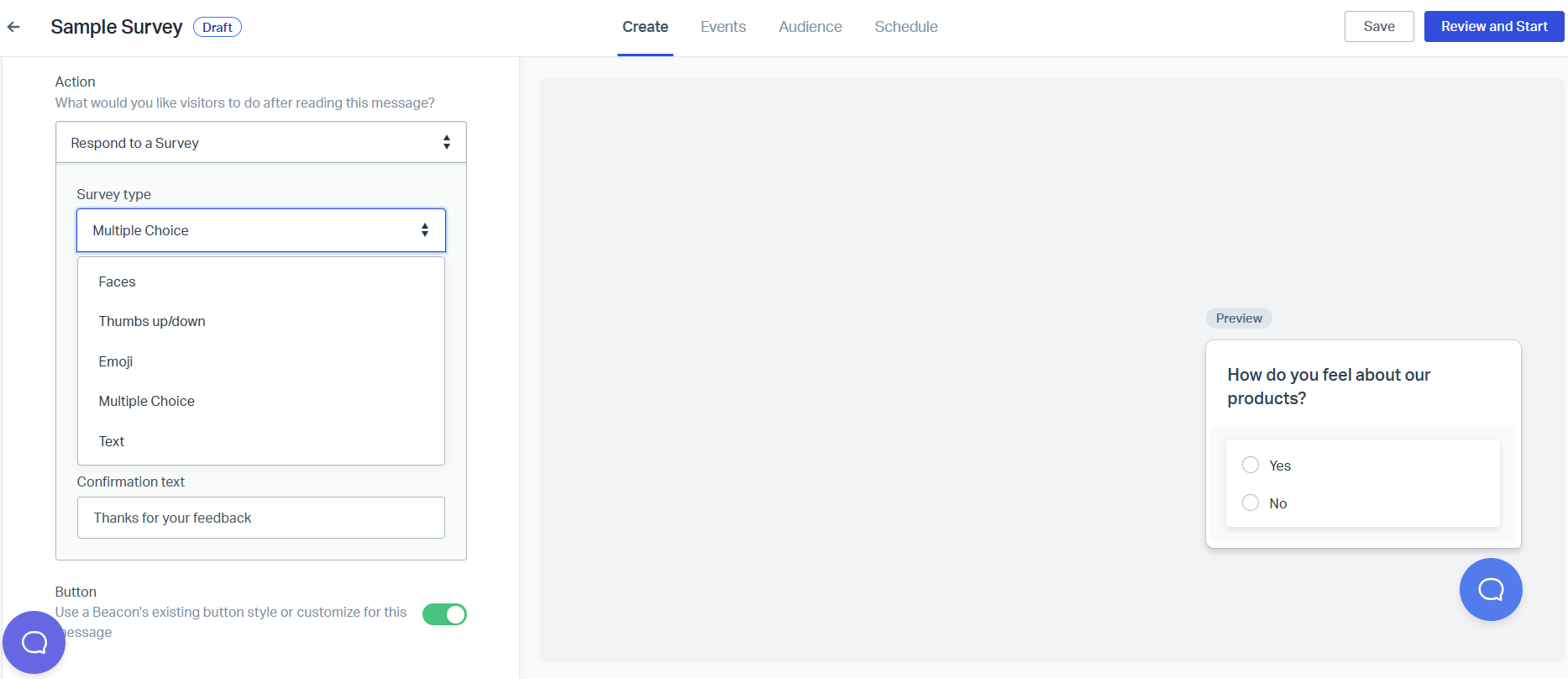
Survey creation.
- When setting up a survey, you can specify whether it should be displayed to first-time visitors or users who complete a pre-defined sequence of actions. Also, you can choose to display the survey to specific user segments. For instance, you can send the survey to users who are trying a feature for the first time.

Event sequence selection.
- After creating a survey, you can analyze the responses in your Help Scout dashboard. However, unlike Userpilot, you don’t have the option to use qualitative user feedback to trigger in-app experiences.
Userpilot vs Help Scout: Which one you should choose?
To further simplify this selection process, let’s break down the strengths and limitations of each tool. Understanding the distinct advantages and potential drawbacks of Userpilot and Help Scout will provide you with a detailed roadmap for making a well-informed decision!
Pros and cons of Userpilot
Pros of Userpilot
As a full-suite digital adoption platform, Userpilot has all the features you need to onboard users, track analytics, and gather feedback from customers without writing a single line of code. Here are a few pros of using Userpilot as your product growth solution:
- No-code builder: Userpilot’s Chrome extension lets you build flows, add UI elements, and tag features without writing a single line of code.
- UI patterns: There are plenty of UI patterns to choose from when using Userpilot, such as hotspots, tooltips, banners, slideouts, modals, and more!
- Startup-friendly: Userpilot’s entry-level plan gives you access to all available UI patterns so you can hit the ground running.
- Walkthroughs and flows: Build engaging interactive walkthroughs and personalized onboarding flows that target specific segments of your user base.
- Self-service support: Build an in-app resource center to help users solve problems, customize its appearance to align it with your brand, and insert various types of content (videos, flows, or chatbots) to keep your customers satisfied.
- A/B testing: Userpilot’s built-in A/B testing capabilities will help you split-test flows, iterate on the best-performing variants, and continually optimize based on user behavior.
- Feedback collection: Userpilot has built-in NPS surveys with its own unified analytics dashboard and response tagging to help you retarget users. There are other survey types to choose from and you can even create your own custom survey.
- Survey templates: There are 14 survey templates to choose from so you can gather feedback on specific features or run customer satisfaction benchmarking surveys like CSAT and CES.
- Advanced analytics: Userpilot lets you analyze product usage data, monitor engagement on all in-app flows, and use the data to create user segments that are based on behaviors instead of demographics.
- Event tracking: Userpilot’s no-code event tracking lets you tag UI interactions (hovers, clicks, or form fills) and group them into a custom event that reflects feature usage.
- Third-party integrations: Userpilot has built-in integrations with tools like Amplitude, Mixpanel, Kissmetrics, Segment, Heap, HubSpot, Intercom, Google Analytics, and Google Tag Manager so you can share data between all the solutions in your tech stack.
Cons of Userpilot
Of course, no tool is perfect and there are a few cons to consider before choosing Userpilot as your user onboarding or product growth solution:
- Employee onboarding: Currently, Userpilot only supports in-app customer onboarding.
- Mobile apps: Userpilot doesn’t have any mobile compatibility which could make it difficult for developers with cross-platform applications to create a consistent user experience for both versions of their product.
- Freemium plan: There’s no freemium Userpilot plan so those bootstrapping their startup and need sub-$100 solutions should consider more affordable onboarding platforms like UserGuiding or Product Fruits.
Pros and cons of Help Scout
Pros of HelpScout
Help Scout’s robust suite of features is designed to facilitate hassle-free and proactive communication with customers. It’s an excellent option when you’re looking to delight users with self-service resources and in-app support.
Key benefits of Help Scout include:
- Easy-to-use interface: Help Scout offers an intuitive and user-friendly platform to streamline customer interactions. You don’t need a ton of technical knowledge to get it up and running.
- Omnichannel support: With Help Scout, you can organize customer conversations from multiple channels, including email, social media platforms, and live chat. It serves as a central location to monitor and resolve user queries and eliminates the trouble of replying to messages on different platforms.
- Hassle-free integrations: With 50+ third-party integrations, Help Scout can fit into your existing tech stack like a glove. The platform is compatible with a wide array of popular tools, including HubSpot, Shopify, Slack, Salesforce, Mailchimp, Facebook Messenger, and more.
- Cost-effective pricing: Help Scout offers affordable plans starting at just $20 per user per month (billed annually). That makes it suitable for businesses with limited budgets.
- Mobile apps: Help Scout offers mobile apps for both Android and iOS devices. That makes it easy for your team members to check and reply to user queries, even if they’re on the move. It helps cut down response times and improves the overall customer experience.
Cons of HelpScout
While Help Scout is known for its powerful feature set and user-friendly interface, the platform has its drawbacks. These include:
- Lack of user onboarding tools: Help Scout does an excellent job of helping businesses monitor and manage customer communication. However, beyond that, it offers limited capabilities to facilitate user onboarding and product adoption. You don’t get the option to create and implement personalized in-app product tours.
- Limited user feedback options: Help Scout’s user feedback collection capabilities are restricted to microsurveys and NPS surveys. If you’re looking to collect more detailed feedback or trigger in-app experiences based on survey responses, the platform won’t meet your needs.
- Basic analytics and reporting: Help Scout provides an overview of the performance of customer support executives, including response times and happiness scores. However, it doesn’t offer in-depth insight into in-app user behavior and engagement like Userpilot does. Also, exporting and sharing reports can be cumbersome.
- Lack of ticketing features: Unlike other help desk solutions, Help Scout doesn’t offer an in-built ticketing system.
Userpilot vs Help Scout – Why Userpilot might be a better choice?
 Help Scout offers several features that help monitor and manage customer support interactions. However, if you’re looking for an all-in-one platform that lets you handhold users with hyper-personalized in-app experience, Help Scout pales in comparison to Userpilot.
Help Scout offers several features that help monitor and manage customer support interactions. However, if you’re looking for an all-in-one platform that lets you handhold users with hyper-personalized in-app experience, Help Scout pales in comparison to Userpilot.
Here are a few areas where Userpilot takes the lead:
- Advanced user onboarding features: Whether you want to create interactive product walkthroughs or onboarding checklists, Userpilot makes the process easy. It offers a no-code interface to design and implement seamless in-app flows. You can even segment users into different groups for personalized onboarding. Help Scout doesn’t offer such functionalities.
- In-depth user analytics: Userpilot offers a detailed glimpse into in-app user behavior to help you understand how different users navigate your product. You can even set up custom events and conversion funnels to track user activity. Help Scout’s analytics capabilities are limited to response times, happiness scores, and other basic metrics.
- Extensive feedback options: Unlike Help Scout, Userpilot doesn’t limit feedback collection to microsurveys and NPS surveys. Instead, you can create and implement a wide array of surveys, including NPS, CSAT, and reaction-based surveys, using pre-designed templates. Also, you can trigger personalized in-app experiences based on qualitative survey responses.
Conclusion
Hopefully, this post helped you decide whether Userpilot or Help Scout is more appropriate for your company. As you can see – both have many upsides and downsides.
However, Userpilot provides a better value for money and is a better choice for a mid-market SaaS, especially when it comes to user onboarding and user feedback.
If you’re interested in finding more, book a demo with our team here!
![]()
Try Userpilot – The Best User Onboarding Solution for SaaS


